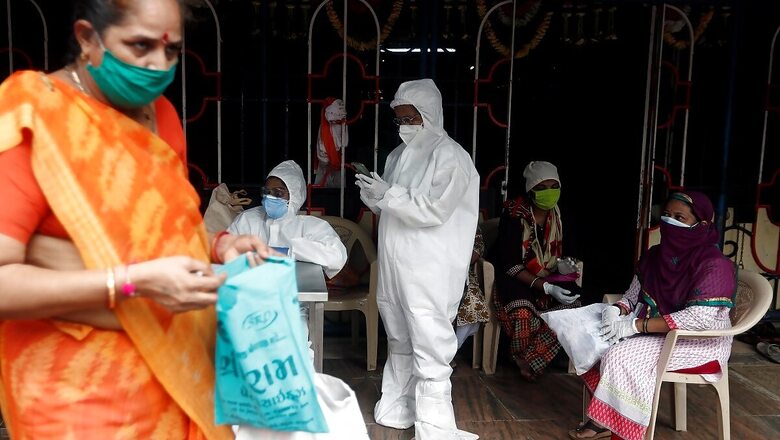
views
Clear blue skies in Delhi and other major cities in India during lockdown was the most positive side of the pandemic. It was a landmark welcome change for netizens, because outdoor air pollution kills around seven million people worldwide each year, as reported in World Health Organisation’s (WHO) latest report, and most of them reside in developing nations.
The World Health Organizations (WHO) declared Coronavirus Disease (COVID-19) as a threat to population’s health on March 11, 2020. Covid-19 has affected the people globally and statistics and data are changing every minute. Air pollution is believed to contribute for worst outcome in Covid-19 as more deaths were reported in polluted areas in comparison to the areas with pollution-free skies.
Air pollution is one of the greatest challenges and there have been discussions at global level for strategic solutions to this important concern. This has become more important at present in view of positive correlation between air pollution and the spread of the coronavirus. These can be well understood with two hypotheses. First, COVID-19, like other viruses, have an airborne transmission, and particulate matter (PM) could act as a carrier to increase the spread of the virus. Secondly, PM could induce damage to lung cells, increase inflammation leading to increase in mortality and this effect can be more pronounced in most polluted areas. In addition to it, air pollution is also known to weaken the immune system, compromising ability to fight off infection.
Long-term exposure to chronically high PM2.5 levels weakens the ability of the lungs to clear off infections due to compromise in immunity, making general population more prone to acquire COVID-19. In addition, traces of SARS-CoV-2 RNA, the genetic material of the virus, can be found on pollution particles, meaning that increased air pollution may act as a vehicle to increase Covid-19 transmission in highly polluted places.
Everyone was bit skeptical about clean air for long term as it was expected that air quality will worsen again after lockdowns are lifted and people return to business as usual. Pollution levels must be limited as much as possible to minimise the effects of a second wave of coronavirus, they warn.
It is critical to understand not only the pollutant types and associated health impacts, but also about our body threshold to tolerate these pollutants. This will help us to understand our susceptibility to air pollution as well as COVID-19. That will help us understand our susceptibility to COVID and other diseases. Air pollution may cause more damage in COVID-19 patients by compromising lung function, or exacerbating chronic lung conditions such as COPD and asthma.
Clean Air
Air pollution indicators changed drastically for better in all major global during coronavirus lockdowns leading to better air quality. People were told to stay at home to prevent the transmission of virus globally. The restrictions during lockdown have given an opportunity to experience clean air breathing in most polluted cities of the world that they have not experiences in last few years.
Air Quality Improvement from Lockdowns
As lockdowns have shut down factories and kept cars off the roads, air pollution levels have fallen drastically. According to this year’s Air Quality Index, cities with historically high levels of PM2.5 have witnessed a dramatic drop in pollution since enforcing lockdowns; 44% in Wuhan, 54% in Seoul and 60% in New Delhi.
If anything, the pandemic only underscores the importance of integrated thinking and approaches. Many countries are now considering large investments to recover from the COVID-19 epidemic. As they make decisions about where these investments should be targeted, considering actions that will sustainably reduce air pollution concentrations can help to protect the health of their populations, as well as deliver other benefits for environment, climate change and development.
Linkage of Air Pollution and COVID-19
Coronavirus has been detected on particles of air pollution. There are many questions unanswered like how long coronavirus can be carried with pollution particles, effect on the number of people infected, viability of virus on pollution particles and sufficient quantity to cause disease.
Previous research has looked at links between COVID-19 mortality and population-based exposure to nitrogen dioxide, ozone, and particulate matter. Though lockdown showered air pollution levels according to some research, other studies have linked higher levels of pollutants to increased levels of COVID-19 infection, hospitalization, and death.
One recent study by Harvard University found that even small increases in fine particulate matter, known as PM2.5, have had an outsized effect in the US. An increase of just 1 microgram per cubic metre corresponded to a 15% increase in Covid-19 deaths. We can understand how badly this virus will affect Delhi population where average level of PM 2.5 has gone to180-300 micrograms per cubic metre.
Another study examined another pollutant, nitrogen dioxide (NO2), across 66 administrative regions in several hard-hit European countries and concluded that long-term exposure to this pollutant may be one of the most important contributors to fatality caused by the COVID-19 virus.
Air Pollution Increases COVID-19 Death Rates
Long-term exposure to air pollution increases vulnerability for most severe form COVID-19 disease and outcomes. An analysis of 3,080 counties in the United States, found that higher levels of the tiny, dangerous particles in the air known as PM 2.5 were associated with higher death rates from the COVID-19 disease.
A study on air quality in Italy found a correlation between COVID-19 mortality rates and high levels of pollution. A study in 2003 found that patients with Sever Acute Respiratory Syndrome (SARS), closely related to Covid-19, were 84% more likely to die if they lived in highly polluted areas.
What Can We Do?
The most effective long-term approaches are directed towards better ventilation and air purification to ensure better air quality at home. Air Purifiers must cross everyone mind, when shopping for the festive season in India keeping air pollution and its effects in mind but there are not enough evidence to support Managing our AQI could potentially result in better Covid-19 outcomes while promoting our overall health and well-being.
Delhi is witnessing a severe air quality these days and this situation is worst news for fight against COVID-19. There is a need for strict regulation and enforcement for protection of air quality to prevent worst outcome from COVID-19 and air pollution as there is growingg evidence of the linkages between poor air quality and negative health outcomes.
Read all the Latest News, Breaking News and Coronavirus News here


















Comments
0 comment